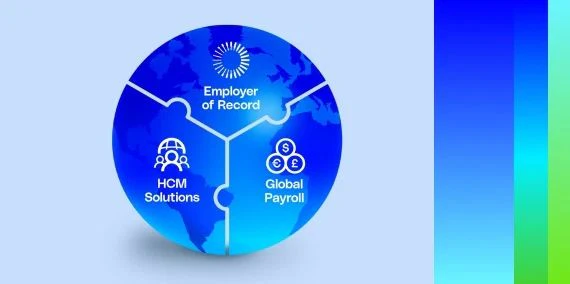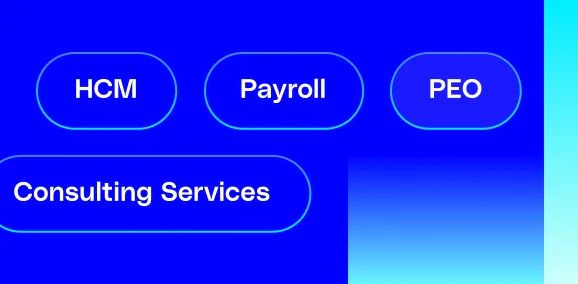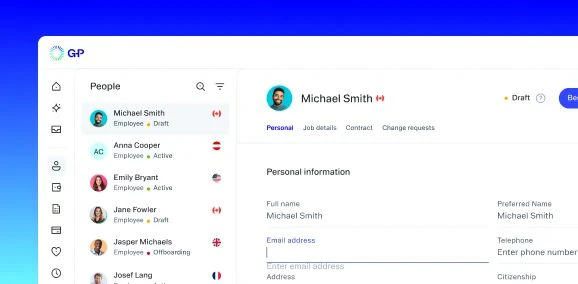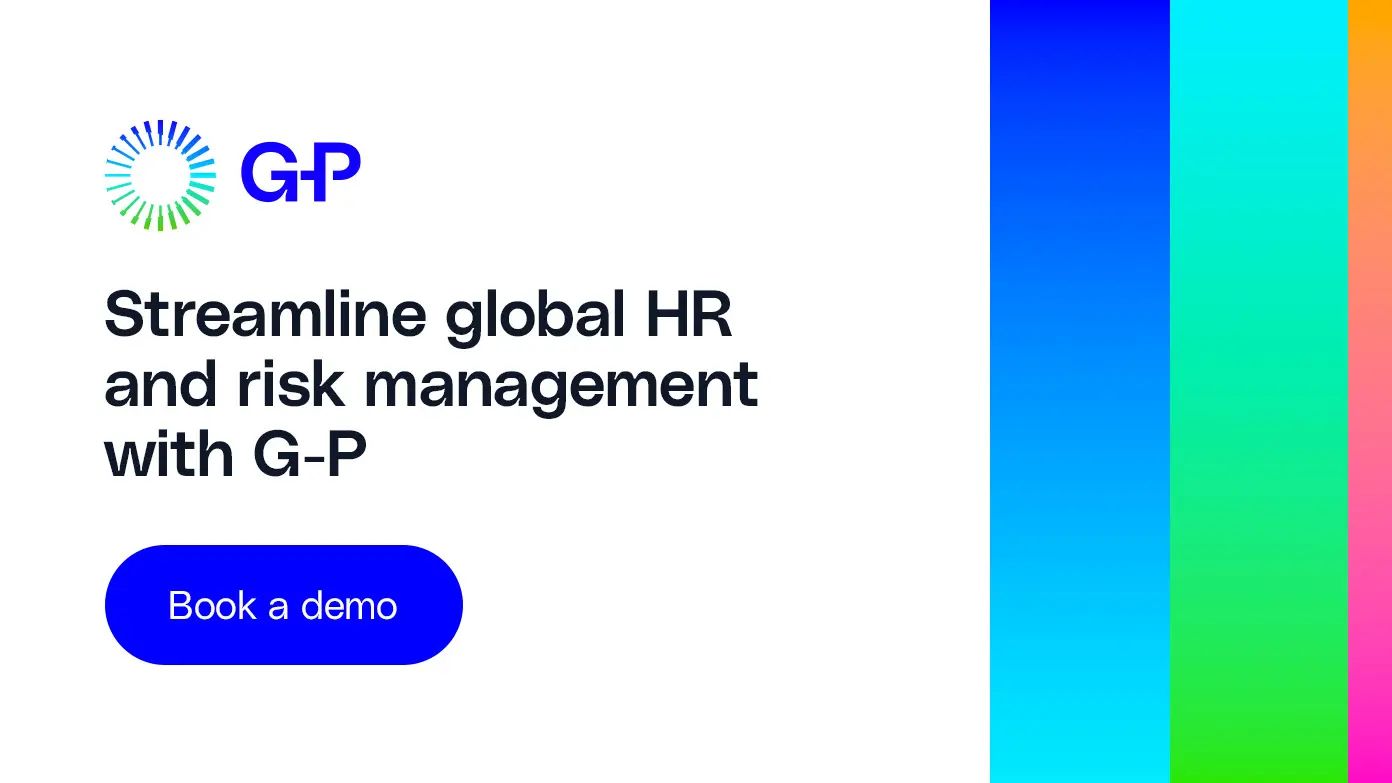A global presence gives you more business opportunities and access to a broad talent pool. But it also brings more HR risks.
A global HR risk management plan is your company's blueprint for smooth global operations. It ensures the right people, processes, and policies are in place to address risks before they escalate.
What is risk management in global HR?
Risk management in HR involves identifying, assessing, and mitigating risks related to employees and the workplace. For global companies, risk management starts with evaluating each country's labor market, employee expectations, and compliance laws. Company-wide and location-specific risk management plans help you stay compliant across all areas.
Why global HR risk management matters
HR risk management strategies allow you to identify the warning signs and act on them to protect your reputation and finances.
Types of risks in global HR
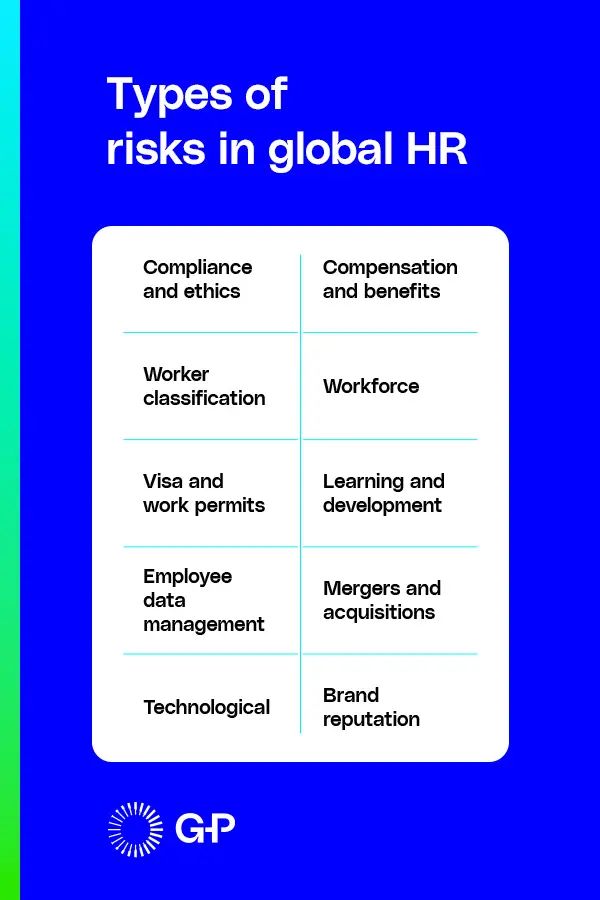
Most global HR risks fall under one of the following categories:
|
Compliance and ethics |
These refer to employment law violations, regulation breaches, or ethical standards. For example, exceeding the maximum weekly work hours can trigger fines, penalties, and even employee lawsuits. Partner with in-country legal experts and schedule regular internal audits. |
|
Worker classification |
Accurate classification of employees and contractors is crucial for tax and benefits compliance. Partner with an employer of record (EOR), or conduct thorough legal research and classification audits to mitigate misclassification risks. |
|
Visa and work permits |
Ensure every employee has the right to work in your country of operation. This involves keeping up with changing immigration laws and navigating visa processes. Partner with experienced professionals who understand immigration regulations. |
|
Employee data management |
Global companies have to comply with both local and international data security standards. Risk mitigation includes establishing cybersecurity protocols, conducting data security audits, and keeping up with evolving data privacy regulations. |
|
Technological |
Establish effective cybersecurity protections and follow AI best practices. Integrate best-in-class solutions across every area of operations, including compliance and payroll. |
|
Compensation and benefits |
Mitigation requires balancing local regulations with employee expectations. Keep track of minimum wage requirements and paid leave entitlements to ensure compliance. |
|
Workforce |
These are the risks involved in managing employee relations and work environments. Implement policies to ensure fair treatment of all employees and conduct surveys to gauge satisfaction. |
|
Learning and development |
Inadequate learning and development can lead to challenges in retention, productivity, and competition. Develop comprehensive training programs tailored to locations and roles, and use online platforms to scale training. |
|
Mergers and acquisitions |
If you’re going through a merger or acquisition, risks of disruption, loss of talent, and operational inefficiencies arise. A detailed integration plan is crucial to retain talent. |
|
Brand reputation |
In the age of viral social media posts, negative publicity spreads fast. Mitigate this risk with a strong code of conduct and standards for managing public criticism. |
How to create a global HR risk management plan
Apply this four-step formula to your company-wide risk management framework.
1. Anticipate risks
Conduct a comprehensive HR audit to highlight general company risks like compliance gaps, cash flow bottlenecks, and industry-specific concerns. Work through all 10 risk areas above to ensure a thorough audit.
Prioritize these risks based on probability, preventability, and severity. The most important risks to plan for are those that are likely to happen and could seriously impact your company, but can be avoided by acting early.
Invite collaboration between departments and engage in-country experts to minimize the risk of blind spots. AI-powered risk intelligence can also help predict and rank risks based on data from your industry and location.
2. Prepare solutions
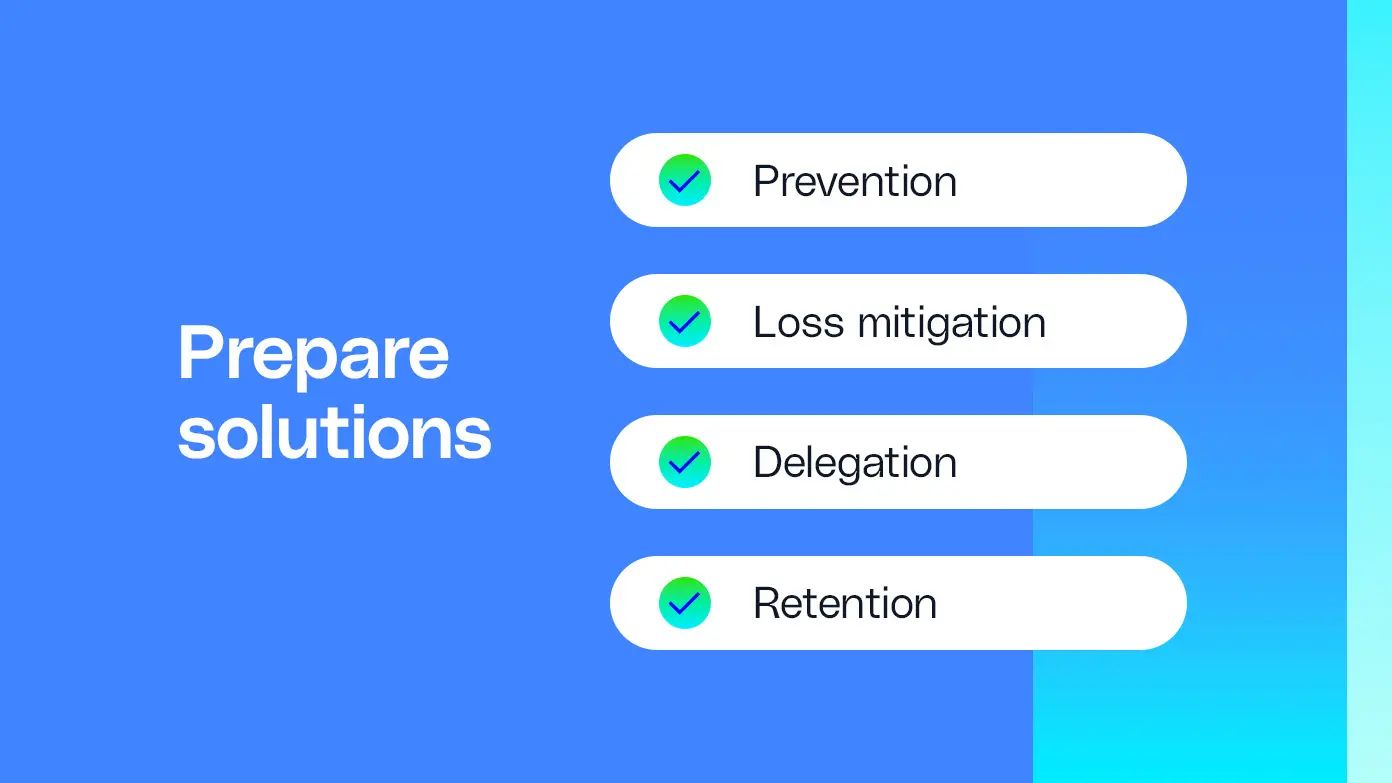
Design proactive solutions to tackle the root causes of potential risks. HR risk management techniques include:
-
Prevention: Stop a risk from happening by addressing its causes. For example, you can avoid litigation by developing clear antidiscrimination training and policies.
-
Loss mitigation: Reduce how often a risk is likely to happen or how severe its impact will be. While employee turnover is unavoidable, you can reduce the impact of resignations and retirements through succession planning and cross-training.
-
Delegation: Transfer compliance management to an EOR. EORs handle all aspects of employment, so you can hire anywhere, without the legal risk.
-
Retention: Decrease employee turnover with a positive, engaging work environment. Retention strategies include competitive salaries and benefits, professional development opportunities, and celebrating employee contributions.
3. Take action
Take proactive measures to respond to risks that have occurred. Timing is crucial in every risk management technique.
HR technologies maximize efficiency and minimize human error. A global HR AI agent like G-P Gia™ can help you mitigate risks by generating compliant interview questions, contracts, policies, and other HR documents. Use Gia to draft or review existing documents for compliance across 50 countries and all 50 U.S. states.
4. Adapt processes
Monitor the results of your risk-management strategies against key performance indicators (KPIs) and refine your processes.
For example, a KPI could be the number of annual compliance errors across all your locations. If you discover compliance gaps or violations, look for the root causes and adapt your strategies to address them. An EOR with in-country legal expertise and a spotless compliance record can help you avoid repeat incidents.
8 tips for successful HR risk mitigation
These tips will help you implement your risk mitigation strategies across global locations.
1. Integrate risk management with daily processes
Integrating risk management into daily HR operations rather than treating it as a siloed function is vital. For example, when creating a new compensation plan, consider risks related to compliance with local wage laws and market rates. Factoring risk management into every HR process supports proactive risk mitigation.
2. Centralize and localize documentation
Centralizing HR policy documents through a cloud-based platform promotes accountability and consistency across all your locations. It's also crucial to adapt documents to local laws and languages. Gia can create, translate, and adapt HR documents to local regulations in seconds.
3. Conduct scenario planning
Scenario planning means asking “what if?” and preparing contingency plans. This includes considering mild, moderate, and severe scenarios specific to each location. Scenarios range from economic fluctuations and political administration changes to natural disasters, pandemics, and armed conflicts.
The scenarios you plan for depend on the location. For example, planning HR actions for dealing with earthquakes is a higher priority in Japan than in Finland.
4. Form strategic partnerships
Partnerships help you identify, mitigate, and manage HR risks. For global compliance, an industry-leading EOR is your ideal partner. An EOR with an established entity in your target location can provide insights about local requirements and expectations. As the legal employer, the EOR manages all matters of compliance, so you don’t have to.
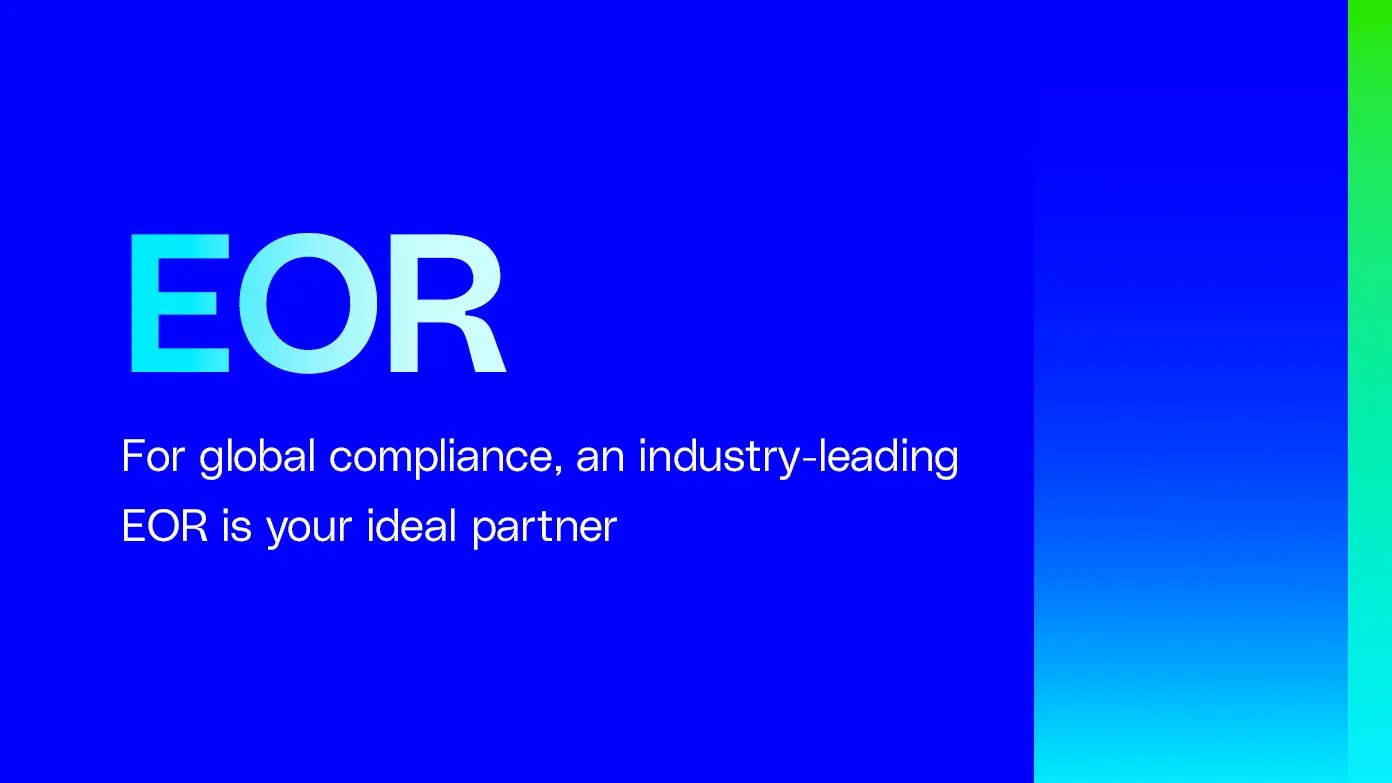
5. Seek buy-in at every level
Cultivate a company-wide commitment to risk mitigation. Loop in other departments to help with risk identification and solution planning. With buy-in at every level, you gain more insights and reduce the chances of negligence.
6. Make continuous improvements
Risk management in HR is an ongoing process that takes continuous improvement, especially when expanding globally. Monitor KPIs like reported incidents, training completion rates, and employee turnover rates. Gather feedback from employees and other stakeholders to identify improvement opportunities. Update your risk management plan as regulations evolve in each of your locations.
7. Upgrade your toolkit
Use innovative HR technologies to reduce human error, enhance efficiency, and support comprehensive risk analysis. An AI-powered global HR agent like Gia generates compliant contracts, reviews policies, and drafts compliant employee communications in seconds. Cut compliance time and costs by up to 95% with Gia.
8. Prioritize compliance
A clean compliance record protects your finances and reputation. However, aligning HR policies to the latest labor laws in each location is the most challenging area of risk mitigation.
There are two main approaches to compliance. One is to rely on internal teams to conduct extensive research and regular audits for each location, and accept liability for any errors. The better alternative is to partner with an EOR to streamline your HR functions and ensure compliance throughout the entire employment lifecycle.
Streamline global HR and risk management with G-P™
Partner with G-P to simplify global HR risk management. As the EOR industry leader, we help companies of all sizes hire in 180+ countries, without setting up new entities. Our AI-powered global employment products and EOR solutions are backed by the largest team of in-country HR, legal, and compliance experts, so you can hire anywhere quickly and compliantly.
Complement your HR risk management strategy with our global HR agent, Gia. Gia brings G-P worldwide compliance expertise to your fingertips. Automate HR document creation and review, and cut compliance costs by up to 95% with Gia. Try Gia today.









